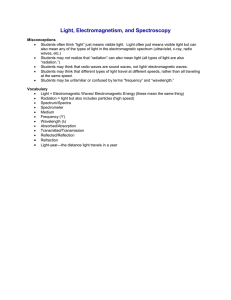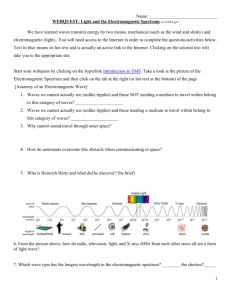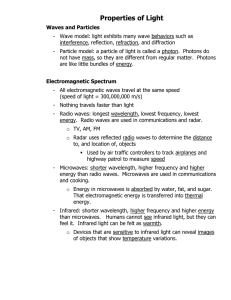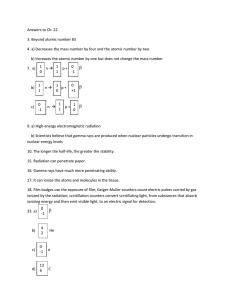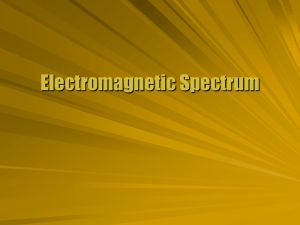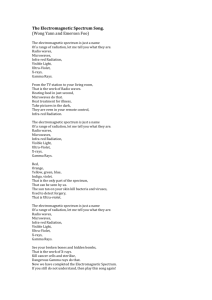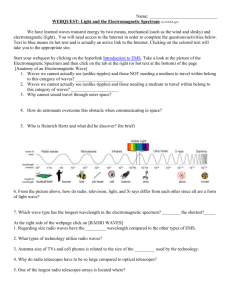Topic 2 – The Electromagnetic Spectrum
advertisement
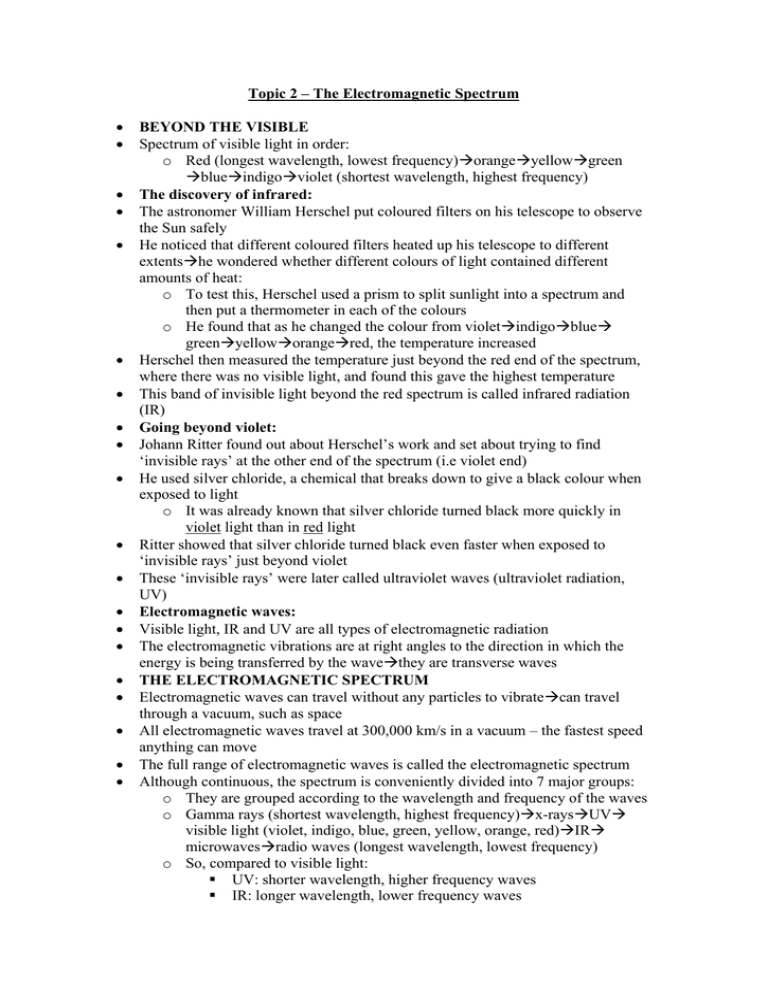
Topic 2 – The Electromagnetic Spectrum BEYOND THE VISIBLE Spectrum of visible light in order: o Red (longest wavelength, lowest frequency)orangeyellowgreen blueindigoviolet (shortest wavelength, highest frequency) The discovery of infrared: The astronomer William Herschel put coloured filters on his telescope to observe the Sun safely He noticed that different coloured filters heated up his telescope to different extentshe wondered whether different colours of light contained different amounts of heat: o To test this, Herschel used a prism to split sunlight into a spectrum and then put a thermometer in each of the colours o He found that as he changed the colour from violetindigoblue greenyelloworangered, the temperature increased Herschel then measured the temperature just beyond the red end of the spectrum, where there was no visible light, and found this gave the highest temperature This band of invisible light beyond the red spectrum is called infrared radiation (IR) Going beyond violet: Johann Ritter found out about Herschel’s work and set about trying to find ‘invisible rays’ at the other end of the spectrum (i.e violet end) He used silver chloride, a chemical that breaks down to give a black colour when exposed to light o It was already known that silver chloride turned black more quickly in violet light than in red light Ritter showed that silver chloride turned black even faster when exposed to ‘invisible rays’ just beyond violet These ‘invisible rays’ were later called ultraviolet waves (ultraviolet radiation, UV) Electromagnetic waves: Visible light, IR and UV are all types of electromagnetic radiation The electromagnetic vibrations are at right angles to the direction in which the energy is being transferred by the wavethey are transverse waves THE ELECTROMAGNETIC SPECTRUM Electromagnetic waves can travel without any particles to vibratecan travel through a vacuum, such as space All electromagnetic waves travel at 300,000 km/s in a vacuum – the fastest speed anything can move The full range of electromagnetic waves is called the electromagnetic spectrum Although continuous, the spectrum is conveniently divided into 7 major groups: o They are grouped according to the wavelength and frequency of the waves o Gamma rays (shortest wavelength, highest frequency)x-raysUV visible light (violet, indigo, blue, green, yellow, orange, red)IR microwavesradio waves (longest wavelength, lowest frequency) o So, compared to visible light: UV: shorter wavelength, higher frequency waves IR: longer wavelength, lower frequency waves o Visible light waves are the only ones visible to the human eye Modern astronomy tries to observe stars and galaxies by detecting various parts of the electromagnetic spectrum they give off: o E.g the Hubble Space telescope can detect visible light, UV and IR DANGERS OF ELECTROMAGNETIC WAVES Microwaves: o The microwave frequency that can heat water is used in microwave ovens o Humans are mostly watermicrowaves can cause internal heating of body cells - potentially dangerous. This is why microwave ovens have shields in them to stop the waves escaping o Mobile phones signal using microwaves, but use different frequenciesdo not pose a health risk IR radiation: o Our skin absorbs IR, which we feel as heat (remember from Herschel’s experiment that IR had higher temperature than visible spectrum) o Too much IR can damage or destroy cellsburns to skin All waves transfer energy. However, higher frequency waves transfer more energy (have greater penetration) are potentially more dangerous… UV radiation: o Sunlight contains UV, which carries more energy than visible radiation o The energy transferred by UV to our cells can damage their DNA o Too much exposure to sunlight (UV)skin cancer o UV in sunlight can also damage eyes (cataracts…clouding of the lens, reducing vision) o to protect yourself from UV radiation, you should put sun cream on and wear sunglasses X-rays and gamma rays: o These waves have higher frequency than UV, carrying even more energy o Excessive exposure to x-rays or gamma rays may cause genetic mutations in DNAcancer USES OF ELECTROMAGNETIC RADIATION Illumination, vision and photography: Visible light is necessary for illumination, vision and photography o E.g the EURion pattern on banknotes (prevents digital copying) can be seen when illuminated because it reflects certain wavelengths of visible light Security: UV: o Some materials absorb UV radiation and re-emit it as visible light – this is called fluorescence o Fluorescence is used to check banknotes – real banknotes fluoresce when UV light is shone onto them o Some security lights use fluorescent lamps – these produce UV waves and use a fluorescent material on the inside of the bulb glass X-ray: o X-ray scanners are used in airports to detect objects hidden on the body as well as in luggage o Both x-rays and gamma rays can penetrate the body, but x-rays transfer less energy than gamma raysare safer... x-rays are used in hospitals to detect broken bones IR radiation: o All warm objects give off some heat as IR radiation o CCTV cameras that detect IR are used to watch people at night – this is called thermal imaging o IR radiation can pass through fogit’s useful in daytime too Communications: Radio waves and microwaves: o Both radio waves and microwaves carry TV signals o Wi-fi wireless connections for computers use radiowaves o Mobile phone signals use microwaves IR radiation: o IR waves carry signals a short distance from remote controls to devices like TVs o IR signals are also sent down optical fibre cables for telephone and internet communications Food and medicine: Gamma rays: o 1. Gamma rays transfer a lot of energy which can kill cells (including those of bacteria/ microorganisms)are used to sterilise food and surgical instruments o 2. They are also used also to kill cancer cells in radiotherapy (gamma rays are aimed at the cancer cells so damage to normal cells is limited) o 3. They can also detect cancer: A chemical that emits gamma rays is injected into the blood The chemical is designed to collect inside cancer cells A scanner then locates the cancer by finding the source of the gamma rays UV radiation: o UV radiation can kill bacteriaused to disinfect water and sewage IONISING RADIATION Gamma rays: Gamma rays are ionising radiation – i.e they can remove electrons from atoms to form ions Ions are very reactiveif atoms in the cell are ionised, the reactions that follow can damage DNA (this is how gamma rays can cause cancer) Some elements naturally emit gamma radiation all the time (e.g radium) – such elements are said to be radioactive Alpha and beta particles: Not all substances emit gamma (γ) waves…others emit alpha (α) and beta (β) particles. Some e.g plutonium give off all three types Alpha and beta are particles of matter with a lot of kinetic energy This energy can ionise atomsalpha and beta particles are also types of ionising radiation like gamma rays, alpha and beta particles can damage DNA inside cells However, unlike gamma rays, they are not electromagnetic radiation
